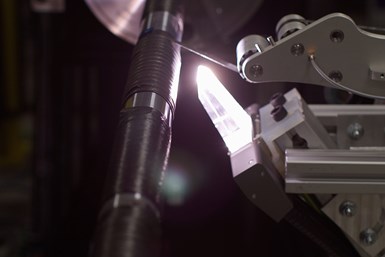Broadband flash lamp heat source improves material deposition
CAMX 2023: Humm3 technology is a broadband flash lamp heat source for AFP, ATL, filament winding and more composite applications, delivering power previously only available from lasers.
Share

The humm3. Photo Credit: Heraeus Noblelight
Heraeus Noblelight’s (Cambridge, U.K. and Gaithersburg, Md., U.S.) broadband flash lamp heat source, the humm3, is a two-time CAMX Award finalist. The heat source is a technology for automated fiber placement (AFP), automated tape laying (ATL), filament winding and other composite applications. Delivering the power previously only available from a laser, the humm3 does not require safety protocols or the costs associated with a Class 4 laser safety enclosure. Users can improve material deposition and, consequently, production rates because of humm3’s scalable heated widths from 12.5 to 300 mm and beyond. Wider widths are available.
The humm3 technology delivers homogeneous, highly controllable heat to the process area over a range of temperatures at rapid process rates. Its instantaneous temperature ramp-up and cooldown is well-suited for processing complex parts using dry fiber and thermoplastic composite materials.
The humm3 product family includes the humm3 Discovery and humm3 Enterprise. Discovery is designed for research and development while Enterprise is good for integration into industrial production, advanced process development or pilot lines. Humm3 Enterprise enables high throughput for components such as pressure vessels, pipes and components in automotive, aerospace, oil and gas and construction industry applications. Integration and control of humm3 Enterprise is said to be simple using its fieldbus communications, robot rated components and “plug-and-play” head connectivity.
In addition to the humm3 product line, Heraeus Nobelight also produces infrared heat technologies designed for increasing production rates and quality in a range of composites processing and fabricating applications. The technologies include electric infrared emitters, modules and systems for curing thermoset plastics and heating thermoplastics prior to welding, molding or forming. Precise control and placement of infrared radiation help to deliver a more efficient composite fabrication process. Example applications include prepreg layup, de-bulking prepreg carbon fiber tape layups, softening of multiple prepreg material prior to molding and more. Short wave emitters provide a rapid response and flexible size for any application. Fast response medium wave emitters integrate easily into production. Carbon medium wave provides a more color-neutral response to substrates while maintaining a quick response rate. Systems can be curated for specific customer needs.
Related Content
-
Manufacturing the MFFD thermoplastic composite fuselage
Demonstrator’s upper, lower shells and assembly prove materials and new processes for lighter, cheaper and more sustainable high-rate future aircraft.
-
Airbus video highlights RACER compound helicopter first flight
Launched as part of a Clean Sky 2 program, a compound design — rotor, split fixed-wing, propulsive propellers — uses composites to cut fuel consumption and emissions by 20%.
-
ATLAM combines composite tape laying, large-scale thermoplastic 3D printing in one printhead
CEAD, GKN Aerospace Deutschland and TU Munich enable additive manufacturing of large composite tools and parts with low CTE and high mechanical properties.












